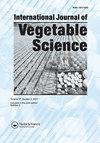Chitosan modifies the substrate and influences growth of chili seedlings
IF 1.1
Q2 Agricultural and Biological Sciences
引用次数: 0
Abstract
ABSTRACTThe addition of chitosan to soil has been shown to promote plant development, although its actions on the soil and the plants remain unclear. Chili (Capsicum annum L.) seedlings were grown in a greenhouse (20–33°C, 65%–70% RH) on a substrate (topsoil, rice husk charcoal, and coconut coir) at a ratio of 2:1:1 (v/v) amended with 0%, 1%, or 10% (w/w) chitosan powder. Shoot and root dry weights of chili seedlings grown in a substrate containing 1% chitosan exhibited a 2.5-fold and 1.6-fold increase compared to those in 0% and 10% chitosan treatments, respectively. Leaf chlorophyll content was 2.7-fold higher at 20 days after transplanting. Chitosan at 1% improved the cation exchange capacity (CEC), substrate organic matter, and plant essential nutrient absorption (P, K, Ca, Mg, Mn, Cu, and Zn). In contrast, the substrate added with 10% chitosan had a negative effect on chili seedlings, possibly due to an excess of total available nitrogen (1.54% or 1.6 times higher) and organic matter (30% or 1.6 times higher). Seedlings exhibited leaf chlorosis, poor root development, and fewer essential nutrients in tissues than the control and 1% chitosan treatments. Use of 1% chitosan appears to promote chili growth by improving substrate characteristics.KEYWORDS: Capsicum annumhot pepperplant nutrientssoil additivesubstrate properties AcknowledgmentsThe authors thank the Thailand Research Fund through the Royal Golden Jubilee PhD Program (Grant No. PHD/0206/2552) for funding this research. We are grateful to Assoc. Prof. Dr Kohei Nakano (Gifu University, Japan) for his advice on soil microorganisms. The authors acknowledge the United Graduate School of Agricultural Science, Gifu University, Japan, for providing facilities.Disclosure statementNo potential conflict of interest was reported by the author(s).Additional informationFundingThe work was supported by the Royal Golden Jubilee Ph. D. Program by Thailand Research Fund [PHD/0206/2552].壳聚糖修饰基质对辣椒幼苗生长的影响
摘要土壤中添加壳聚糖可促进植物生长发育,但其对土壤和植物的作用尚不清楚。辣椒(Capsicum annum L.)幼苗在温室(20-33°C, 65%-70% RH)中生长,基质(表土,稻壳炭和椰壳)以2:1:1 (v/v)的比例添加0%,1%或10% (w/w)的壳聚糖粉。与0%和10%壳聚糖处理相比,1%壳聚糖处理辣椒幼苗的茎部和根干重分别增加了2.5倍和1.6倍。移栽后第20天叶片叶绿素含量增加2.7倍。1%的壳聚糖提高了阳离子交换量(CEC)、基质有机质和植物必需营养物质(P、K、Ca、Mg、Mn、Cu和Zn)的吸收。而添加10%壳聚糖的底物对辣椒幼苗的生长有负面影响,可能是由于总有效氮(高出1.54%或1.6倍)和有机质(高出30%或1.6倍)过量。与对照和1%壳聚糖处理相比,幼苗表现出叶片萎黄、根系发育不良、组织必需营养素减少的特点。1%壳聚糖通过改善基质特性促进辣椒生长。关键词:辣椒、辣椒、植物营养成分、土壤添加剂、基质特性致谢作者通过皇家金禧博士项目(批准号:No. 5)感谢泰国研究基金。PHD/0206/2552)资助本研究。我们非常感谢协会。中野Kohei博士教授(日本岐阜大学)就土壤微生物提出的建议。作者感谢日本岐阜大学农业科学联合研究生院提供的设施。披露声明作者未报告潜在的利益冲突。这项工作得到了泰国研究基金[PHD/0206/2552]的皇家金禧博士项目的支持。
本文章由计算机程序翻译,如有差异,请以英文原文为准。
求助全文
约1分钟内获得全文
求助全文
来源期刊

International Journal of Vegetable Science
Agricultural and Biological Sciences-Plant Science
CiteScore
3.10
自引率
0.00%
发文量
30
期刊介绍:
The International Journal of Vegetable Science features innovative articles on all aspects of vegetable production, including growth regulation, pest management, sustainable production, harvesting, handling, storage, shipping, and final consumption. Researchers, practitioners, and academics present current findings on new crops and protected culture as well as traditional crops, examine marketing trends in the commercial vegetable industry, and address vital issues of concern to breeders, production managers, and processors working in all continents where vegetables are grown.
 求助内容:
求助内容: 应助结果提醒方式:
应助结果提醒方式:


